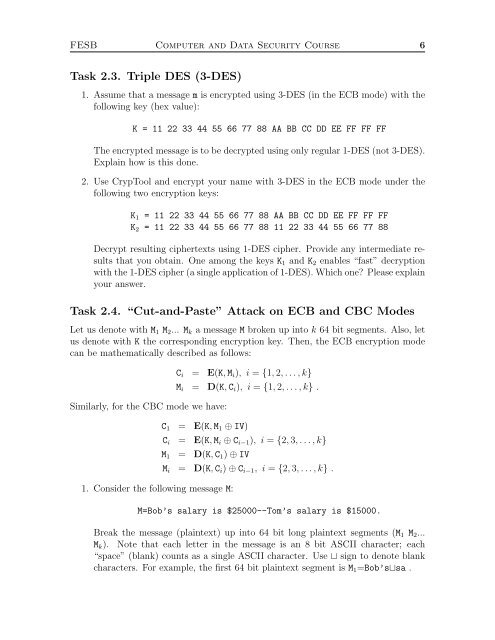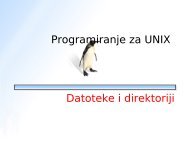Laboratory Exercises II: Symmetric and Asymmetric Cryptography
Laboratory Exercises II: Symmetric and Asymmetric Cryptography
Laboratory Exercises II: Symmetric and Asymmetric Cryptography
You also want an ePaper? Increase the reach of your titles
YUMPU automatically turns print PDFs into web optimized ePapers that Google loves.
FESB Computer <strong>and</strong> Data Security Course 6<br />
Task 2.3. Triple DES (3-DES)<br />
1. Assume that a message m is encrypted using 3-DES (in the ECB mode) with the<br />
following key (hex value):<br />
K = 11 22 33 44 55 66 77 88 AA BB CC DD EE FF FF FF<br />
The encrypted message is to be decrypted using only regular 1-DES (not 3-DES).<br />
Explain how is this done.<br />
2. Use CrypTool <strong>and</strong> encrypt your name with 3-DES in the ECB mode under the<br />
following two encryption keys:<br />
K1 = 11 22 33 44 55 66 77 88 AA BB CC DD EE FF FF FF<br />
K2 = 11 22 33 44 55 66 77 88 11 22 33 44 55 66 77 88<br />
Decrypt resulting ciphertexts using 1-DES cipher. Provide any intermediate results<br />
that you obtain. One among the keys K1 <strong>and</strong> K2 enables “fast” decryption<br />
with the 1-DES cipher (a single application of 1-DES). Which one? Please explain<br />
your answer.<br />
Task 2.4. “Cut-<strong>and</strong>-Paste” Attack on ECB <strong>and</strong> CBC Modes<br />
Let us denote with M1 M2... Mk a message M broken up into k 64 bit segments. Also, let<br />
us denote with K the corresponding encryption key. Then, the ECB encryption mode<br />
can be mathematically described as follows:<br />
Similarly, for the CBC mode we have:<br />
Ci = E(K, Mi), i = {1, 2, . . . , k}<br />
Mi = D(K, Ci), i = {1, 2, . . . , k} .<br />
C1 = E(K, M1 ⊕ IV)<br />
Ci = E(K, Mi ⊕ Ci−1), i = {2, 3, . . . , k}<br />
M1 = D(K, C1) ⊕ IV<br />
1. Consider the following message M:<br />
Mi = D(K, Ci) ⊕ Ci−1, i = {2, 3, . . . , k} .<br />
M=Bob’s salary is $25000--Tom’s salary is $15000.<br />
Break the message (plaintext) up into 64 bit long plaintext segments (M1 M2...<br />
Mk). Note that each letter in the message is an 8 bit ASC<strong>II</strong> character; each<br />
“space” (blank) counts as a single ASC<strong>II</strong> character. Use ⊔ sign to denote blank<br />
characters. For example, the first 64 bit plaintext segment is M1=Bob’s⊔sa .

















